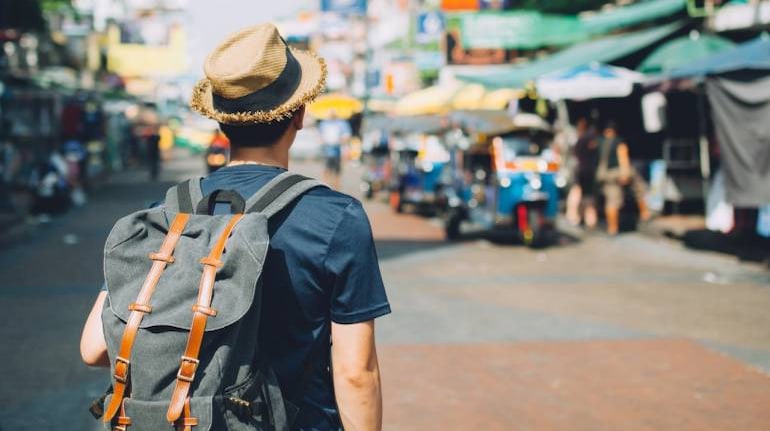What happened to all those Chinese tourists?
What happened to all those Chinese tourists? Moneycontrol



Will the tourists ever return? Southeast Asia could be waiting a long time.
Sustainable Development Goals (SDGs)
Goal 8: Decent Work and Economic Growth
- Promote sustained, inclusive, and sustainable economic growth, full and productive employment, and decent work for all.
- Develop policies to promote productive activities, job creation, entrepreneurship, and innovation.
- Promote sustainable tourism that creates jobs and promotes local culture and products.
Introduction
Before COVID, Malaysia’s luxury mall beneath Kuala Lumpur’s iconic Petronas Towers echoed with the sound of Chinese tourists and their dialects. But recently, during a busy dinner hour, they were missing. Din, the mall’s outlet of famous Taiwanese chain Din Tai Fung, a favorite of Chinese tourists, was half-full with local Malaysians and Middle Eastern customers. When I asked a cashier whether they had served many Chinese lately, she shook her head with a tight smile.
That’s a problem.
The Impact of Chinese Tourists
China was once the world’s most plentiful source of international tourists, and Southeast Asia was among their top destinations. The buildup happened quickly. In the 2000s, affluence, a growing surplus of leisure time, and a relaxation of government travel restrictions made tourism available to China’s rapidly expanding middle class. From 2009 to 2019, the number of travelers grew from 47.7 million to 154.63 million.
These new tourists spent handsomely. In 2019, Chinese accounted for one-fifth, or $255 billion, of international tourism spending. The effect on Southeast Asia was immense. Tourist receipts accounted for 5.7 percent of Malaysia’s gross domestic product in 2019, and Chinese tourists accounted for 17.8 percent of that revenue. Similarly, 11.4 percent of Thailand’s GDP was generated by tourism, with a whopping 28.1 percent accounted for by Chinese spending.
The Impact of COVID-19
COVID interrupted the trend, but many governments and businesses believed it would be temporary. That turned out to be false. In 2021, Chinese tourists fell below 2000 levels to 8.5 million globally; in Southeast Asia, the arrivals dropped to negligible levels. The recovery, so far, has been disappointing. Chinese bookings of summer tours this year are at 30 percent of their pre-pandemic levels in Malaysia and 10 percent in Thailand.
Challenges and Structural Issues
There are several problems. Flight capacity, especially between China and Southeast Asia, hasn’t returned to 2019 levels, and China’s economic downturn is making the country’s consumers cautious. Both problems will reverse eventually, but Southeast Asia’s travel sector shouldn’t count on a return to the booming 2010s when they do.
Long term, deep structural issues exist. First, younger Chinese are no longer interested in the group travel experiences that long dominated Chinese holidays, which their parents took overseas. A recent survey of 2,000 likely Chinese travelers found that 76 percent were seeking “fewer people” and fewer itineraries driven by online posts. Rather, today’s Chinese travelers are seeking “niche” experiences that provide access to unique cultural attractions. Phuket’s crowded beaches and chains like Din Tai Fung don’t qualify.
Second, Chinese are spending more money at home, especially on luxury goods. In 2019, Chinese accounted for 35 percent of the global luxury market, yet just 11 percent of their purchases were made in China thanks to high taxes at home. Luxury boutiques and duty-free shops in places like Bangkok, Phuket, and Kuala Lumpur were the beneficiaries. But thanks to a government effort to open duty-free shops at home, luxury sales are expanding quickly in China and could account for nearly 90 percent of Asia-Pacific’s duty-free sales in a few years.
Finally, there’s the ever-present risk of politically motivated interruptions. For example, in 2017 China banned Chinese tour groups from visiting South Korea in retaliation for the deployment of a US-built missile defense system, causing billions of dollars in losses to South Korean business. Southeast Asia has yet to experience a tourist trade retaliation, but as tensions over the South China Sea grow, tourism-dependent countries must be prepared to be squeezed.
Expanding Tourism Opportunities
It’s time for Southeast Asia to expand the welcome mat. Destinations across the region cultivated growth by customizing hotels and other travel experiences for Chinese tourists, expanding air routes, easing visas, and developing marketing relationships in China.
In the short term, it’s impossible for Southeast Asian countries to make up for China’s missing tourists. But in the long term, countries should expand tourist marketing and outreach to other countries with expanding middle classes. India is a good place to start. Like China in the 1990s, it’s home to an increasingly affluent population with a bug to travel and a growing airline industry. Cultivating the Indian tourist market will require taking many of the same steps that Thailand, Malaysia, and other countries have long taken with China: ease visa policies, expand air links, and assist hotels, restaurants, and attractions in customizing their offerings for Indian arrival.
India won’t soon make up for the decline in China tourists. But by diversifying its tourist marketing, Southeast Asia sets itself up for a more sustainable tourism industry. For years, the region rushed out the welcome mat for China. India and other countries should receive an invitation, too.
Adam Minter is a Bloomberg Opinion columnist covering Asia, technology, and the environment. Views are personal and do not represent the stand of this publication.
Credit: Bloomberg
SDGs, Targets, and Indicators
1. Which SDGs are addressed or connected to the issues highlighted in the article?
- SDG 8: Decent Work and Economic Growth
- SDG 12: Responsible Consumption and Production
- SDG 14: Life Below Water
- SDG 17: Partnerships for the Goals
2. What specific targets under those SDGs can be identified based on the article’s content?
- SDG 8.9: By 2030, devise and implement policies to promote sustainable tourism that creates jobs and promotes local culture and products.
- SDG 12.8: By 2030, ensure that people everywhere have the relevant information and awareness for sustainable development and lifestyles in harmony with nature.
- SDG 14.7: By 2030, increase the economic benefits to small island developing states and least developed countries from the sustainable use of marine resources, including through sustainable management of fisheries, aquaculture, and tourism.
- SDG 17.17: Encourage and promote effective public, public-private, and civil society partnerships, building on the experience and resourcing strategies of partnerships.
3. Are there any indicators mentioned or implied in the article that can be used to measure progress towards the identified targets?
- Number of Chinese tourists visiting Southeast Asia
- Percentage of international tourism spending by Chinese tourists
- Tourist receipts as a percentage of GDP
- Number of Chinese arrivals to specific countries
- Booking levels of Chinese tourists for summer tours
- Percentage of global luxury market accounted for by Chinese consumers
- Percentage of duty-free sales in the Asia-Pacific region accounted for by China
Table: SDGs, Targets, and Indicators
| SDGs | Targets | Indicators |
|---|---|---|
| SDG 8: Decent Work and Economic Growth | Target 8.9: By 2030, devise and implement policies to promote sustainable tourism that creates jobs and promotes local culture and products. | – Number of Chinese tourists visiting Southeast Asia – Tourist receipts as a percentage of GDP |
| SDG 12: Responsible Consumption and Production | Target 12.8: By 2030, ensure that people everywhere have the relevant information and awareness for sustainable development and lifestyles in harmony with nature. | – Percentage of international tourism spending by Chinese tourists – Percentage of global luxury market accounted for by Chinese consumers |
| SDG 14: Life Below Water | Target 14.7: By 2030, increase the economic benefits to small island developing states and least developed countries from the sustainable use of marine resources, including through sustainable management of fisheries, aquaculture, and tourism. | – Number of Chinese arrivals to specific countries |
| SDG 17: Partnerships for the Goals | Target 17.17: Encourage and promote effective public, public-private, and civil society partnerships, building on the experience and resourcing strategies of partnerships. | – Booking levels of Chinese tourists for summer tours |
Behold! This splendid article springs forth from the wellspring of knowledge, shaped by a wondrous proprietary AI technology that delved into a vast ocean of data, illuminating the path towards the Sustainable Development Goals. Remember that all rights are reserved by SDG Investors LLC, empowering us to champion progress together.
Source: moneycontrol.com

Join us, as fellow seekers of change, on a transformative journey at https://sdgtalks.ai/welcome, where you can become a member and actively contribute to shaping a brighter future.







